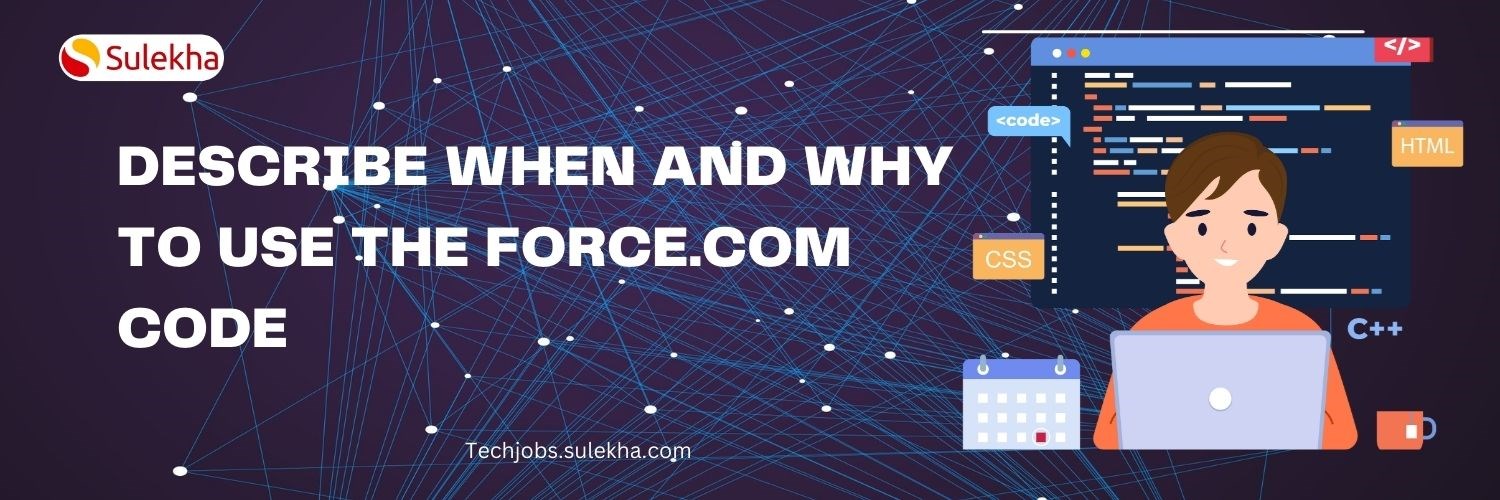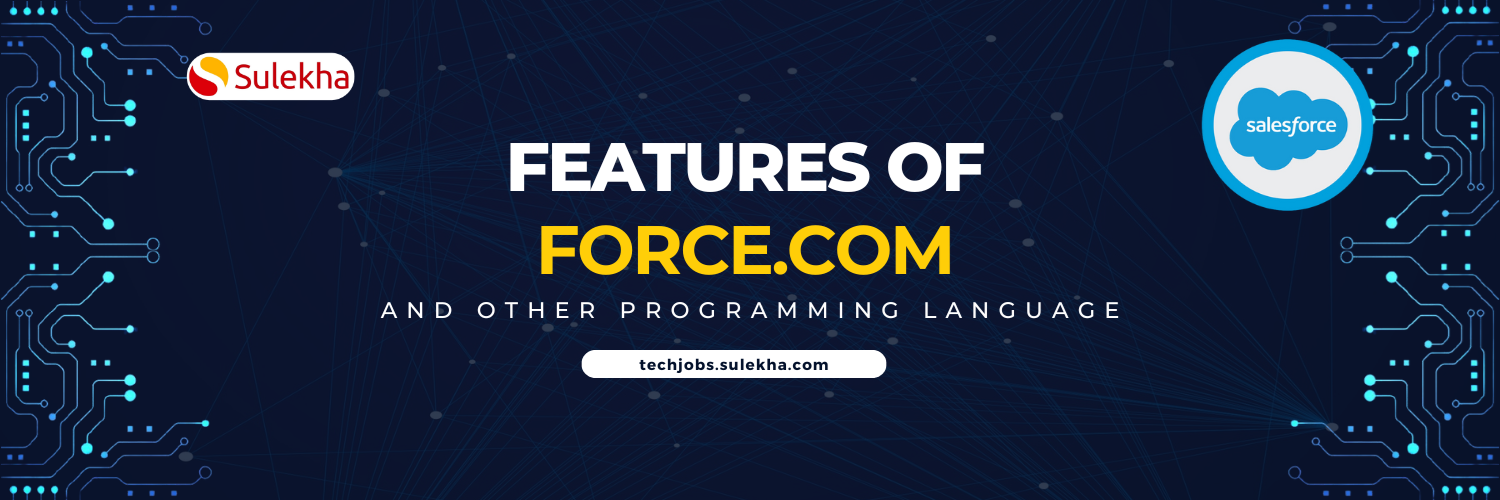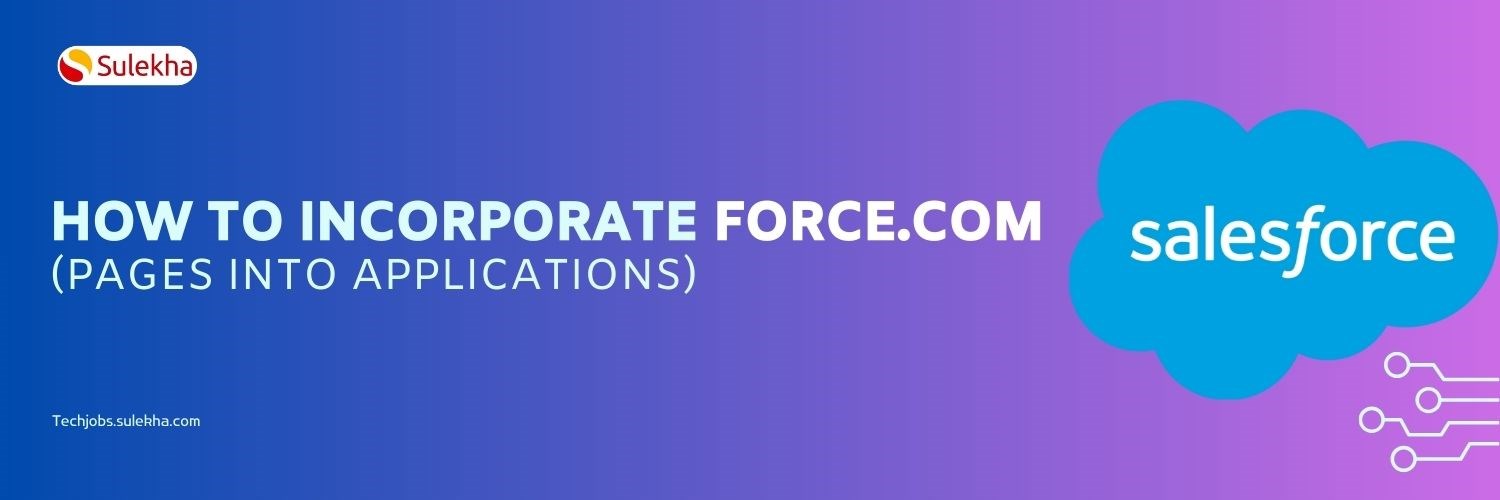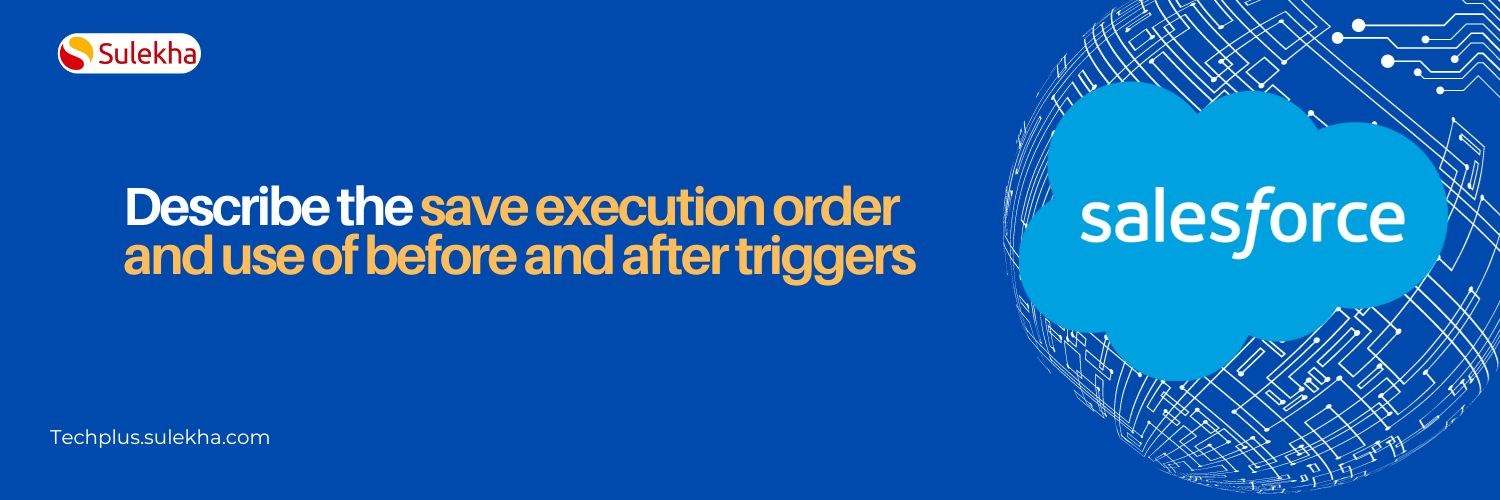Describe when and why to use the Force.com code

Embracing Force.com code, mainly through the Apex programming language, is a strategic choice for developers navigating the expansive realm of the Salesforce ecosystem. Force.com code is employed in various scenarios as a specialized and powerful tool to address specific needs and intricacies inherent to building applications within this cloud-based platform.
Let's delve into the nuanced situations where leveraging Force.com code becomes advantageous and often essential to unlock the full potential of customizations, integrations, and seamless user experiences in Salesforce applications. To learn Salesforce applications and its crucial features, you can Salesforce certification course.
When to Use Force.com Code (Apex)
1. Custom Business Logic: Force.com code is ideal when implementing custom business logic specific to your organization's processes. Apex allows you to tailor applications to your unique requirements, accommodating complex workflows and rules.
2. Integration with Salesforce Data: Apex is the go-to language if your application requires seamless interaction with Salesforce data. It allows you to query, manipulate, and update Salesforce records, ensuring tight integration with your CRM processes.
3. Event-Driven Operations: Force.com code, mainly through triggers written in Apex, excels in responding to events such as record insertions, updates, or deletions. This is invaluable for automating actions based on real-time changes in your Salesforce data.
4. Web Services Integration: When integrating your Salesforce application with external web services, Apex provides robust features for consuming and exposing SOAP and RESTful services, facilitating data exchange with other systems.
5. Complex Algorithms and Calculations: If your application requires intricate algorithms or complex calculations, Apex supports these with its object-oriented structure, allowing you to encapsulate logic within classes and methods.
6. Custom User Interfaces: While Salesforce provides declarative tools for building user interfaces, Force.com code becomes essential when you need highly customized or dynamic interfaces. Visualforce, a markup language in Apex, enables the creation of custom UIs.
Why Use Force.com Code
1. Platform Integration: Apex is explicitly designed for the Force.com platform, offering unparalleled integration with Salesforce services and data. It ensures that your application seamlessly aligns with the broader Salesforce ecosystem.
2. Governor Limits and Resource Management: Force.com enforces governor limits to manage resources efficiently. This ensures that your code operates within defined boundaries, preventing resource overuse and maintaining the overall stability of the platform.
3. Declarative-Programmatic Synergy: While Salesforce emphasizes declarative development, code becomes essential in some scenarios. Apex provides a seamless bridge between declarative and programmatic development, allowing developers to leverage the strengths of both approaches.
4. Security and Permissions: Apex allows you to implement fine-grained control over data access and permissions, ensuring that your application adheres to your organization's security policies.
5. Scalability and Performance: Applications built with Apex benefit from the scalability and performance optimizations inherent in the Force.com platform, making it well-suited for enterprise-level solutions.
In conclusion, utilizing Force.com code, exemplified by the Apex programming language, becomes imperative when aiming for a tailored, integrated, scalable solution within the Salesforce ecosystem. Whether customizing business logic, orchestrating seamless data interactions, responding to real-time events, or achieving a delicate balance between declarative and programmatic development, Force.com code is the linchpin for success.
Its close alignment with the Salesforce platform and features like governor limits and the ability to bridge the gap between declarative and programmatic paradigms solidify its role in crafting robust, enterprise-level applications. Choosing Force.com code is not just a technical decision; it's a strategic move towards precision, optimization, and innovation in the dynamic landscape of cloud-based application development.
Find a course provider to learn Salesforce
Java training | J2EE training | J2EE Jboss training | Apache JMeter trainingTake the next step towards your professional goals in Salesforce
Don't hesitate to talk with our course advisor right now
Receive a call
Contact NowMake a call
+1-732-338-7323Take our FREE Skill Assessment Test to discover your strengths and earn a certificate upon completion.
Enroll for the next batch
Salesforce Course Online Training
- Dec 16 2025
- Online
Salesforce Course Online Training
- Dec 17 2025
- Online
Salesforce Course Online Training
- Dec 18 2025
- Online
Salesforce Course Online Training
- Dec 19 2025
- Online
Related blogs on Salesforce to learn more

INTRODUCTION TO CLINICAL RESEARCH
Learn the fundamentals of clinical trials, and eight phases of the clinical research process.

Features of Force.com code and distinguish between Force.com code and other programming languages.
Learn how to seamlessly integrate Force.com pages into your Salesforce applications to enhance user experience and discover the steps to create, customize, and deploy custom pages that meet your specific business needs.

List and Describe Syntax Features of Force.com Code
Master the syntax features of Force.com code and description for each feature.
An Introduction: Integrating with the Salesforce Force.com Platform
Unlock the full potential of your Salesforce implementation by integrating it with external systems and applications.

Describe How to Incorporate Force.com Pages into Force.com Applications
Learn how to seamlessly integrate Force.com pages into your Salesforce applications to enhance user experience and discover the steps to create, customize, and deploy custom pages that meet your specific business needs.

Describe the save execution order and use of before and after triggers
Learn how to write triggers that execute at the right time to meet your specific business needs

Debugging, Testing, and Monitoring in Force.com: A Comprehensive Guide
Explore the essential techniques for debugging, testing, and monitoring your Force.com applications.
A Comprehensive Guide to Managing Static Resources in Salesforce
We have discussed the types of Static Resources, how to Create & Use Static Resources and best Practices for Managing Static Resources in Salesforce
Introduction to Force.com Sites – Overview
Learn about the features, benefits, and use cases for Force.com Sites, and discover how to create a custom website that integrates with your Salesforce data and workflows.
Distinguish between standard controllers, custom controllers, and extensions
This guide covers the features, benefits, and use cases for each type of controller, helping you to build more efficient and effective Salesforce applications.
Latest blogs on technology to explore

From Student to AI Pro: What Does Prompt Engineering Entail and How Do You Start?
Explore the growing field of prompt engineering, a vital skill for AI enthusiasts. Learn how to craft optimized prompts for tools like ChatGPT and Gemini, and discover the career opportunities and skills needed to succeed in this fast-evolving indust

How Security Classification Guides Strengthen Data Protection in Modern Cybersecurity
A Security Classification Guide (SCG) defines data protection standards, ensuring sensitive information is handled securely across all levels. By outlining confidentiality, access controls, and declassification procedures, SCGs strengthen cybersecuri

Artificial Intelligence – A Growing Field of Study for Modern Learners
Artificial Intelligence is becoming a top study choice due to high job demand and future scope. This blog explains key subjects, career opportunities, and a simple AI study roadmap to help beginners start learning and build a strong career in the AI

Java in 2026: Why This ‘Old’ Language Is Still Your Golden Ticket to a Tech Career (And Where to Learn It!
Think Java is old news? Think again! 90% of Fortune 500 companies (yes, including Google, Amazon, and Netflix) run on Java (Oracle, 2025). From Android apps to banking systems, Java is the backbone of tech—and Sulekha IT Services is your fast track t

From Student to AI Pro: What Does Prompt Engineering Entail and How Do You Start?
Learn what prompt engineering is, why it matters, and how students and professionals can start mastering AI tools like ChatGPT, Gemini, and Copilot.

Cyber Security in 2025: The Golden Ticket to a Future-Proof Career
Cyber security jobs are growing 35% faster than any other tech field (U.S. Bureau of Labor Statistics, 2024)—and the average salary is $100,000+ per year! In a world where data breaches cost businesses $4.45 million on average (IBM, 2024), cyber secu

SAP SD in 2025: Your Ticket to a High-Flying IT Career
In the fast-paced world of IT and enterprise software, SAP SD (Sales and Distribution) is the secret sauce that keeps businesses running smoothly. Whether it’s managing customer orders, pricing, shipping, or billing, SAP SD is the backbone of sales o

SAP FICO in 2025: Salary, Jobs & How to Get Certified
AP FICO professionals earn $90,000–$130,000/year in the USA and Canada—and demand is skyrocketing! If you’re eyeing a future-proof IT career, SAP FICO (Financial Accounting & Controlling) is your golden ticket. But where do you start? Sulekha IT Serv

Train Like an AI Engineer: The Smartest Career Move You’ll Make This Year!
Why AI Engineering Is the Hottest Skillset Right Now From self-driving cars to chatbots that sound eerily human, Artificial Intelligence is no longer science fiction — it’s the backbone of modern tech. And guess what? Companies across the USA and Can

Confidence Intervals & Hypothesis Tests: The Data Science Path to Generalization
Learn how confidence intervals and hypothesis tests turn sample data into reliable population insights in data science. Understand CLT, p-values, and significance to generalize results, quantify uncertainty, and make evidence-based decisions.